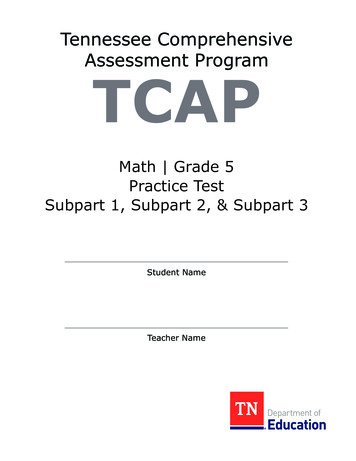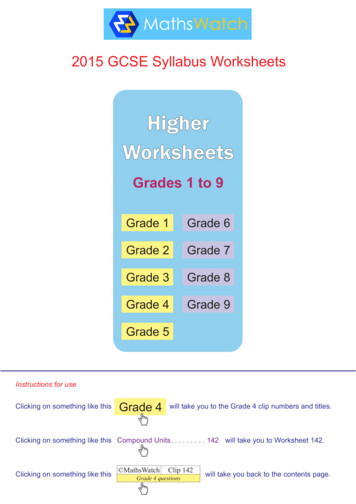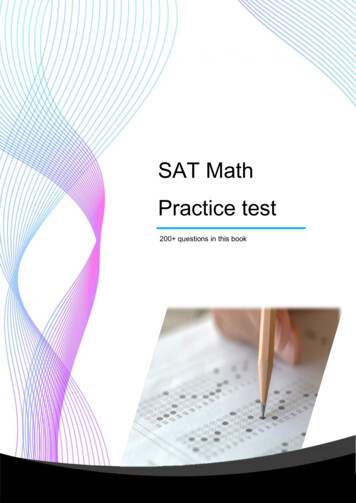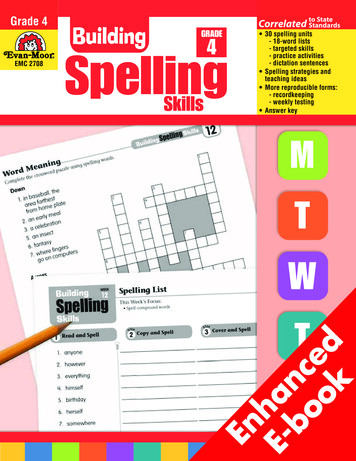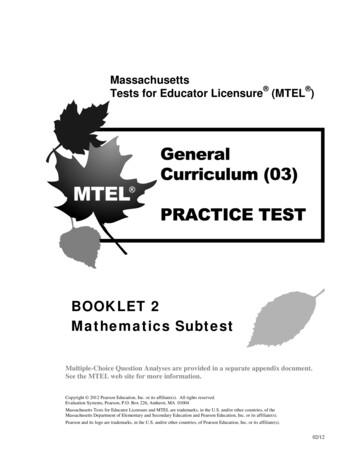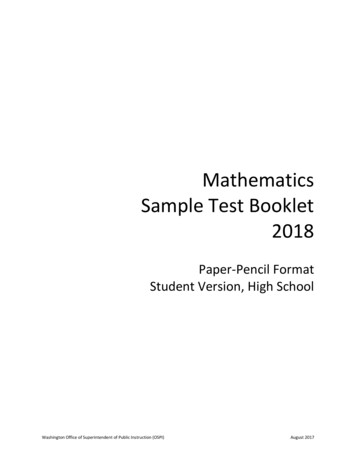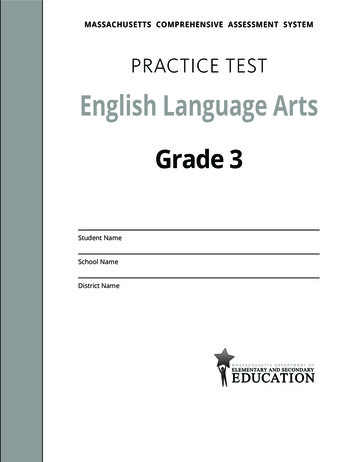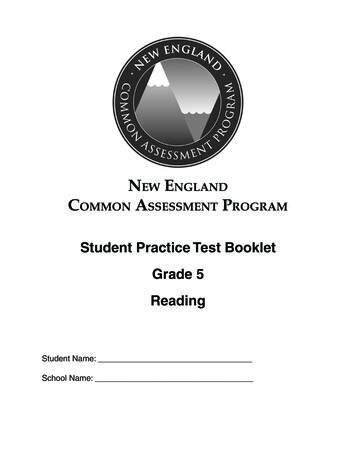
Transcription
Student Practice Test BookletGrade 5ReadingStudent Name:School Name:
Reading—Session 1Answer questions 1 and 2 on page 2.ID:203102 B CommonID:203120 D CommonBelow are four words and their meanings fromthe glossary of a science book.The star football player can weavearound the other team’s players.biology – the study of lifewecology – the study of the relationshipof organisms to their environmentA. One of the crafts at camp was toweave a basket.B. Thoughtful people weave ideas allduring the day.C. Tiny spiders weave their webs acrosssmall bushes.D. Two police cars weave through theafternoon traffic.entomology – the study of insectsornithology – the study of birdsqWhat does the word radiology mean?A.B.C.D.radios and their partsthe study of X-raysthe use of radonradical ideas in science1NECAP PT2004-2005 Grade-5 Read F-1Which sentence best shows how theword weave is used in the box above?
Read the following two poems. Then answer the questions that follow.Drops510A teardroplooks like sadnessand has a salty taste.A raindrop tastes of skyand brings a shower.A dewdrop is a new drop,a taste-of-morning-brewdropand is probably deliciousto a flower.—Constance LevyApril Rain SongLet the rain kiss you.Let the rain beat upon your head with silver liquid drops.Let the rain sing you a lullaby.5The rain makes still pools on the sidewalk.The rain makes running pools in the gutter.The rain plays a little sleep-song on our roof at night—And I love the rain.—Langston Hughes2NECAP PT2004-2005 Grade-5 Read F-1
Answer questions 3 through 6 on page 2.ID:200170 D CommonID:200171 A CommonetThe poet’s message in the poem“Drops” is toA. tell the reader a story aboutdewdrops.B. persuade the reader to go out intothe rain.C. explain how tears are like dew.D. describe different kinds of drops.In “April Rain Song,” the poet showsthe rain as bothA.B.C.D.gentle and strong.lips and head.silver and gold.drops and sheets.ID:200173 D CommonyID:200172 B CommonrLine 6 of “April Rain Song” says, “Therain plays a little sleep-song.” Whichphrase means the same as “sleep-song”?A.B.C.D.In “April Rain Song,” the poet describesall of the following except howA. the sound of rain helps some peoplesleep.B. the rain makes puddles on thesidewalk.C. the rain makes moving pools in thegutter.D. the sun comes out and creates arainbow.“silver liquid drops”“a lullaby”“still pools on the sidewalk”“the gutter”Answer question 7 on page 2.ID:200177 CommonuIn the last line of the poem “April Rain Song,” the poet writes, “And I love the rain.”Explain how the poet shows his feelings about the rain throughout the poem. Use specificexamples from the poem to support your answer.3NECAP PT2004-2005 Grade-5 Read F-1
Read the article explaining how to make a compass. Then answer the questions that follow.How Can You Make a Compass?by Gabriel ReubenGather the following equipment: A barmagnet, a 6-inch piece of thread, a needle,a pin, a small piece of cellophane tape, anempty jar with a cover, and a compass.Follow this procedure:1. Tie one end of the thread around themiddle of the magnet so that the magnetbalances when you hold it by the thread.When the magnet stops swaying, see whichway the north pole is pointing. Compare thiswith the way the compass needle is pointing.NSYou will observe: When the magnet comesto rest, the north pole points north.2. Rub the needle lengthwise along one ofthe poles of the magnet; each stroke must be inthe same direction, not back and forth. Whenthe needle is magnetized enough to attract thepin, tie the thread around the middle of theneedle so that it balances. Tape the other end ofthe thread to the inside of the jar cover. Lowerthe needle into the jar so that it hangs freelywhen you tighten the cover. Compare the waythe compass and the needle point.You will observe: The needle is now acompass. It points north, as does the compass.The earth itself is a tremendous magnet.The magnetic poles of the earth are said tobe huge deposits of magnetite. The north4NECAP PT2004-2005 Grade-5 Read F-1NSEmagnetic pole is about 1400 miles away fromthe geographic North Pole, and the southmagnetic pole is about 1400 miles awayfrom the geographic South Pole. The earth’smagnetic poles change position from time totime. Magnets are attracted to the magneticpoles. This is why the poles of magnets arecalled north-seeking and south-seeking, andwhy magnets can serve as compasses.Because the magnetic poles andgeographic poles are not at the same place,mariners and others who must get accurateinformation from their compasses correcttheir compass reading with a chart whichcompensates for the error of the compass invarious locations. The disparity between themagnetic and geographic poles is called theangle of declination. The magnet points totrue north only in those places which lie in astraight line with the north geographic poleand the north magnetic pole.It is said that the earth’s magnetic fieldcauses objects made of iron, nickel, or cobaltanywhere in the world to become magnetizedif they remain unmoved for very long periodsof time.WARNING: Don’t let the magnet get too closeto the compass. The magnet can attract thecompass needle and weaken its effectiveness.7W
Answer questions 8 through 11 on page 3.ID:202119 C CommonID:202127 A Commoni1)According to the article, why shouldyou tie one end of the thread around themiddle of the magnet?A. so the magnetB. so the magnetcompassC. so the magnethold it upD. so the magnetand forthWhich way do you need to rub theneedle on the magnet?A. lengthwise along one of the polesand in one directionB. lengthwise across both poles and inone directionC. lengthwise along one of the polesand back and forthD. lengthwise across both poles andback and forthdoes not fallwill attract thebalances when youwill not move backID:202122 D CommonID:202128 B Commono1!One way to weaken a compass is toA.B.C.D.let the compass get too hot.tie the compass up with thread.rub a needle on the compass.let the compass get too close to amagnet.To make a compass, which of thesewould you do first?A. Lower a needle into a jar.B. Rub a needle along one of the polesof a magnet.C. Tape the end of a thread to theinside of a jar cover.D. Tie a thread around the middle of aneedle.Answer question 12 on page 3.ID:202141 Common1@What are the main ideas in this article? Explain your answer by using information fromthe article.5NECAP PT2004-2005 Grade-5 Read F-1
Answer questions 13 through 16 on page 4.ID:202130 D CommonID:202137 B Common1#1%In paragraph 7, the word y.huge.If you wanted to know the meaning ofthe term angle of declination from thisarticle, where would you look?A.B.C.D.indexglossaryheadingstable of contentsID:202125 D Common1 The picture is meant to show all of thefollowing exceptID:202132 A Common1 A. what the bar magnet and thecompass look like.B. how to hold the bar magnet and thecompass.C. where to put the string on the barmagnet.D. that the bar magnet and the compasspoint in different directions.If left unmoved for a long time, iron,nickel, or cobalt can becomeA.B.C.D.magnetized.compasses.magnetic poles.north-seeking.Answer question 17 on page 4.ID:202144 Common1&In your own words, tell how to make your own compass. Use information from the articleto support your answer.6NECAP PT2004-2005 Grade-5 Read F-1
Acknowledgments“Drops” (p. 2) from Splash by Constance Levy. Published by Orchard Books, an imprint of Scholastic. Copyright 2002by Constance Levy.“April Rain Song” (p. 2) from The Collected Poems of Langston Hughes. Published by Random House, Inc. Copyright 1994by The Estate of Langston Hughes.“How Can You Make a Compass?” (p. 4) from Electricity Experiments for Children by Gabriel Reuben. Published by SterlingPublishing. Copyright 1960 by Sterling Publishing.
Student Practice Test Booklet Grade 5 Reading Student Name: _ School Name: _ 1 Reading—Session 1 Answer questions 1 and 2 on page 2. ID:203102 B Common Below are four words and their meanings from the glossary of a science boo

